[English] 日本語
 Yorodumi
Yorodumi- PDB-7v47: Type 1A alpha-synuclein fibril seeded by cerebrospinal fluid from... -
+ Open data
Open data
- Basic information
Basic information
| Entry | Database: PDB / ID: 7v47 | ||||||
|---|---|---|---|---|---|---|---|
| Title | Type 1A alpha-synuclein fibril seeded by cerebrospinal fluid from a preclinical Parkinson's disease patient | ||||||
 Components Components | Alpha-synuclein | ||||||
 Keywords Keywords | PROTEIN FIBRIL / amyloid fibril | ||||||
| Function / homology |  Function and homology information Function and homology informationnegative regulation of mitochondrial electron transport, NADH to ubiquinone / : / neutral lipid metabolic process / regulation of acyl-CoA biosynthetic process / negative regulation of dopamine uptake involved in synaptic transmission / negative regulation of norepinephrine uptake / response to desipramine / positive regulation of SNARE complex assembly / positive regulation of hydrogen peroxide catabolic process / supramolecular fiber ...negative regulation of mitochondrial electron transport, NADH to ubiquinone / : / neutral lipid metabolic process / regulation of acyl-CoA biosynthetic process / negative regulation of dopamine uptake involved in synaptic transmission / negative regulation of norepinephrine uptake / response to desipramine / positive regulation of SNARE complex assembly / positive regulation of hydrogen peroxide catabolic process / supramolecular fiber / regulation of synaptic vesicle recycling / negative regulation of chaperone-mediated autophagy / mitochondrial membrane organization / regulation of reactive oxygen species biosynthetic process / negative regulation of platelet-derived growth factor receptor signaling pathway / positive regulation of protein localization to cell periphery / negative regulation of exocytosis / regulation of glutamate secretion / dopamine biosynthetic process / response to iron(II) ion / SNARE complex assembly / positive regulation of neurotransmitter secretion / negative regulation of dopamine metabolic process / regulation of macrophage activation / positive regulation of inositol phosphate biosynthetic process / regulation of norepinephrine uptake / negative regulation of microtubule polymerization / regulation of locomotion / synaptic vesicle transport / transporter regulator activity / synaptic vesicle priming / dopamine uptake involved in synaptic transmission / protein kinase inhibitor activity / regulation of dopamine secretion / mitochondrial ATP synthesis coupled electron transport / dynein complex binding / negative regulation of thrombin-activated receptor signaling pathway / positive regulation of receptor recycling / cuprous ion binding / nuclear outer membrane / response to magnesium ion / positive regulation of exocytosis / synaptic vesicle exocytosis / positive regulation of endocytosis / kinesin binding / synaptic vesicle endocytosis / enzyme inhibitor activity / cysteine-type endopeptidase inhibitor activity / regulation of presynapse assembly / response to type II interferon / negative regulation of serotonin uptake / alpha-tubulin binding / beta-tubulin binding / phospholipase binding / behavioral response to cocaine / supramolecular fiber organization / phospholipid metabolic process / cellular response to fibroblast growth factor stimulus / inclusion body / axon terminus / Hsp70 protein binding / cellular response to epinephrine stimulus / response to interleukin-1 / regulation of microtubule cytoskeleton organization / cellular response to copper ion / positive regulation of release of sequestered calcium ion into cytosol / adult locomotory behavior / SNARE binding / excitatory postsynaptic potential / protein tetramerization / phosphoprotein binding / microglial cell activation / ferrous iron binding / fatty acid metabolic process / regulation of long-term neuronal synaptic plasticity / synapse organization / protein destabilization / PKR-mediated signaling / phospholipid binding / receptor internalization / tau protein binding / long-term synaptic potentiation / terminal bouton / positive regulation of inflammatory response / synaptic vesicle membrane / actin cytoskeleton / growth cone / actin binding / cellular response to oxidative stress / neuron apoptotic process / cell cortex / histone binding / response to lipopolysaccharide / microtubule binding / chemical synaptic transmission / amyloid fibril formation / molecular adaptor activity / negative regulation of neuron apoptotic process / mitochondrial outer membrane / oxidoreductase activity Similarity search - Function | ||||||
| Biological species |  Homo sapiens (human) Homo sapiens (human) | ||||||
| Method | ELECTRON MICROSCOPY / helical reconstruction / cryo EM / Resolution: 2.8 Å | ||||||
 Authors Authors | Fan, Y. / Sun, Y.P. / Wang, J. / Liu, C. | ||||||
| Funding support | 1items
| ||||||
 Citation Citation |  Journal: Structure / Year: 2023 Journal: Structure / Year: 2023Title: Conformational change of α-synuclein fibrils in cerebrospinal fluid from different clinical phases of Parkinson's disease. Authors: Yun Fan / Yunpeng Sun / Wenbo Yu / Youqi Tao / Wencheng Xia / Yiqi Liu / Qinyue Zhao / Yilin Tang / Yimin Sun / Fengtao Liu / Qin Cao / Jianjun Wu / Cong Liu / Jian Wang / Dan Li /  Abstract: α-Synuclein (α-syn) has been shown to form various conformational fibrils associated with different synucleinopathies. But whether the conformation of α-syn fibrils changes during disease ...α-Synuclein (α-syn) has been shown to form various conformational fibrils associated with different synucleinopathies. But whether the conformation of α-syn fibrils changes during disease progression is unclear. Here, we amplified α-syn aggregates from the cerebrospinal fluid (CSF) of patients with Parkinson's disease (PD) staged in preclinical PD (pre-PD), middle- to late-stage PD (mid-PD), and late-stage PD (late-PD). Our results show that α-syn fibrils derived from the late-PD patient are most potent in inducing endogenous α-syn aggregation in primary neurons, followed by the mid-PD and pre-PD fibrils. By using cryo-electron microscopy, we further determined the high-resolution structures of the CSF-amplified fibrils. The structures exhibit remarkable differences in a minor but significant population of conformational species in different staged samples. Our work demonstrates structural and pathological differences between α-syn fibrils derived from PD patients at a spectrum of clinical stages, which suggests potential conformational transition of α-syn fibrils during the progression of PD. | ||||||
| History |
|
- Structure visualization
Structure visualization
| Structure viewer | Molecule:  Molmil Molmil Jmol/JSmol Jmol/JSmol |
|---|
- Downloads & links
Downloads & links
- Download
Download
| PDBx/mmCIF format |  7v47.cif.gz 7v47.cif.gz | 68.9 KB | Display |  PDBx/mmCIF format PDBx/mmCIF format |
|---|---|---|---|---|
| PDB format |  pdb7v47.ent.gz pdb7v47.ent.gz | 49.9 KB | Display |  PDB format PDB format |
| PDBx/mmJSON format |  7v47.json.gz 7v47.json.gz | Tree view |  PDBx/mmJSON format PDBx/mmJSON format | |
| Others |  Other downloads Other downloads |
-Validation report
| Summary document |  7v47_validation.pdf.gz 7v47_validation.pdf.gz | 713.3 KB | Display |  wwPDB validaton report wwPDB validaton report |
|---|---|---|---|---|
| Full document |  7v47_full_validation.pdf.gz 7v47_full_validation.pdf.gz | 714.7 KB | Display | |
| Data in XML |  7v47_validation.xml.gz 7v47_validation.xml.gz | 20.8 KB | Display | |
| Data in CIF |  7v47_validation.cif.gz 7v47_validation.cif.gz | 30.5 KB | Display | |
| Arichive directory |  https://data.pdbj.org/pub/pdb/validation_reports/v4/7v47 https://data.pdbj.org/pub/pdb/validation_reports/v4/7v47 ftp://data.pdbj.org/pub/pdb/validation_reports/v4/7v47 ftp://data.pdbj.org/pub/pdb/validation_reports/v4/7v47 | HTTPS FTP |
-Related structure data
| Related structure data |  31702MC 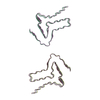 7v48C 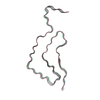 7v49C 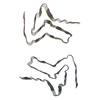 7xo0C  7xo1C 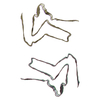 7xo2C 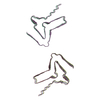 7xo3C 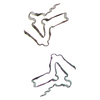 8h03C 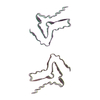 8h04C  8h05C M: map data used to model this data C: citing same article ( |
|---|---|
| Similar structure data | Similarity search - Function & homology  F&H Search F&H Search |
- Links
Links
- Assembly
Assembly
| Deposited unit | 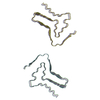
|
|---|---|
| 1 |
|
- Components
Components
| #1: Protein | Mass: 14476.108 Da / Num. of mol.: 6 Source method: isolated from a genetically manipulated source Source: (gene. exp.)  Homo sapiens (human) / Gene: SNCA, NACP, PARK1 / Production host: Homo sapiens (human) / Gene: SNCA, NACP, PARK1 / Production host:  |
|---|
-Experimental details
-Experiment
| Experiment | Method: ELECTRON MICROSCOPY |
|---|---|
| EM experiment | Aggregation state: FILAMENT / 3D reconstruction method: helical reconstruction |
- Sample preparation
Sample preparation
| Component | Name: Type 1A alpha-synuclein fibril seeded by cerebrospinal fluid from a preclinical Parkinson's disease patient Type: ORGANELLE OR CELLULAR COMPONENT / Entity ID: all / Source: RECOMBINANT |
|---|---|
| Molecular weight | Experimental value: NO |
| Source (natural) | Organism:  Homo sapiens (human) Homo sapiens (human) |
| Source (recombinant) | Organism:  |
| Buffer solution | pH: 6.5 |
| Specimen | Embedding applied: NO / Shadowing applied: NO / Staining applied: NO / Vitrification applied: YES |
| Vitrification | Cryogen name: ETHANE |
- Electron microscopy imaging
Electron microscopy imaging
| Experimental equipment |  Model: Titan Krios / Image courtesy: FEI Company |
|---|---|
| Microscopy | Model: FEI TITAN KRIOS |
| Electron gun | Electron source:  FIELD EMISSION GUN / Accelerating voltage: 300 kV / Illumination mode: FLOOD BEAM FIELD EMISSION GUN / Accelerating voltage: 300 kV / Illumination mode: FLOOD BEAM |
| Electron lens | Mode: BRIGHT FIELD / Nominal defocus max: 2000 nm / Nominal defocus min: 1000 nm |
| Image recording | Electron dose: 55 e/Å2 / Film or detector model: GATAN K3 (6k x 4k) |
- Processing
Processing
| CTF correction | Type: NONE |
|---|---|
| Helical symmerty | Angular rotation/subunit: 179.44 ° / Axial rise/subunit: 2.44 Å / Axial symmetry: C1 |
| 3D reconstruction | Resolution: 2.8 Å / Resolution method: FSC 0.143 CUT-OFF / Num. of particles: 69047 / Symmetry type: HELICAL |
 Movie
Movie Controller
Controller








 PDBj
PDBj
